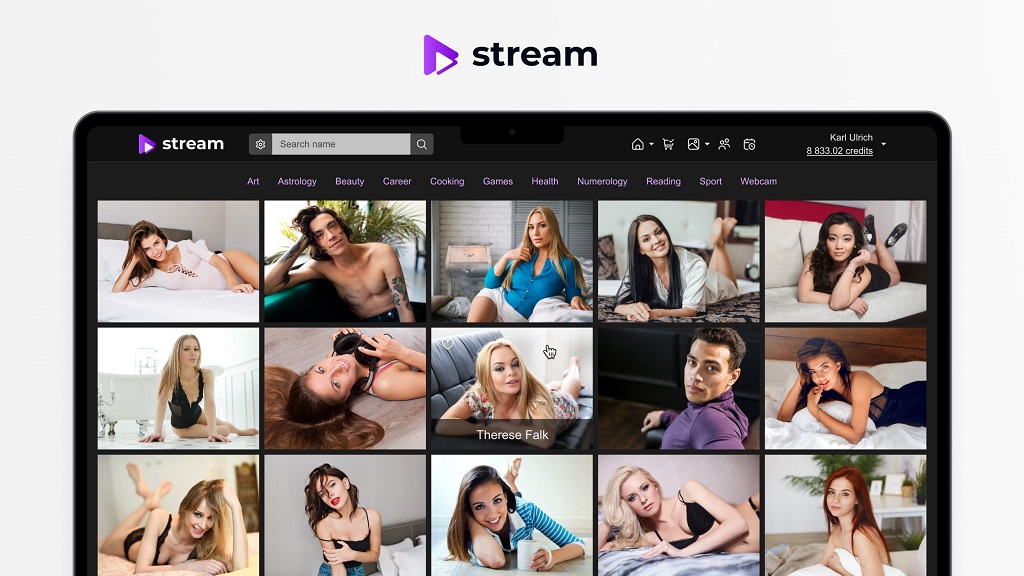
What is adaptive bitrate streaming? It’s the tech that decides whether your stream looks like crisp HD — or pixelated mush — depending on your viewer’s connection. Think of it as your stream’s built-in traffic cop, constantly adjusting the video quality so things keep flowing smoothly, even when Wi-Fi turns unreliable.
Let’s be blunt: buffering kills business. Especially if you’re running an adult live show, a coaching webinar, or a premium event where attention equals revenue. Viewers won’t sit around waiting for a frozen screen to catch up. They’ll bounce — and take their money with them.
That’s why adaptive bitrate streaming matters. It adapts and doesn’t assume every user has fiber-optic speeds or perfect 5G. Instead, it reacts in real time, shifting video quality up or down to avoid the dreaded loading wheel of death.
This article cuts through the fluff. No textbook definitions, no dev-talk. Just five actionable tips to help you stream smarter — whether you’re running a solo cam site, a private video portal, or anything in between..
Understand How Adaptive Streaming Actually Works

You’ve heard the term tossed around: adaptive streaming, adaptive bitrate, video abr… but what does it actually do under the hood? And why should you care?
If you’re running any kind of paid stream — especially high-traffic or mobile-first shows — the tech behind your playback engine is make-or-break for viewer retention. Let’s pull back the curtain.
The Brain Behind the Playback
Adaptive bitrate streaming works like this: instead of sending out a single video feed, your server prepares multiple versions of your stream — same content, different qualities and file sizes.
From there, the real magic happens on the viewer’s device. The player constantly monitors their internet speed, CPU load, and memory use. Based on that, it picks the best-quality stream they can handle at that moment — and swaps up or down as needed. That smart decision-making? It’s thanks to ABR algorithms.
These algorithms run quietly in the background, keeping things watchable — whether your user’s on high-speed Wi-Fi or stuck on weak mobile data. Platforms using abr streaming tech don’t force viewers to pick a quality setting. The system adapts on the fly.
Here’s what the viewer never has to see:
- Buffering wheels mid-show
- Crashes from overloaded streams
- Unwatchable, blurry mess when bandwidth drops
You can thank video abr for that.
Why It Beats Fixed Bitrate
Fixed bitrate streaming is like betting it all on one horse. Too high, and your stream stutters or fails. Too low, and it looks like a VHS tape.
Adaptive bitrate solves that. It’s a must if your audience includes:
- Mobile-first viewers
- Users in areas with unstable networks
- International traffic where speeds vary wildly
Adapt or get abandoned. That’s the bottom line.
Comparison Table — Fixed Bitrate vs Adaptive
| Feature | Fixed Bitrate Streaming | Adaptive Bitrate Streaming |
| Quality Consistency | Static | Dynamic |
| Buffering on Bad Network | High Risk | Significantly Lower |
| Device Adaptability | Low | High |
| Mobile Optimization | Poor | Excellent |
| Uptime & Viewer Retention | Unpredictable | Significantly Better |
Test Like You Mean It — Across Devices and Bandwidths

So your stream looks flawless on your fiber connection, 4K monitor, and latest MacBook. Great — for you. But what about that user watching from a café in rural Brazil on 3G? Or the guy on a cracked Android phone riding the subway?
This is where most streamers mess up.
Adaptive bitrate streaming isn’t a magic fix. It only works if you prep it to handle real-world messiness. That means testing across devices, OS versions, browser types — and especially across wildly different network conditions.
- Open your stream on an iPhone 12 over LTE.
- Try an older Samsung tablet on weak WiFi.
- Run it on low-end Windows laptops with background apps eating RAM.
You’ll quickly find out where your adaptive streaming logic holds — and where it collapses.
And here’s the hard truth: abr streaming won’t save you if you don’t simulate bad conditions during QA. It’s easy to get cocky when the preview window looks crisp. But your viewers live in the wild. Your stream needs to survive there too.
This isn’t about pixel-peeping perfection. It’s about making sure no one drops off your stream just because their signal dipped or their phone overheated.
Test like you mean it. Because your viewer retention literally depends on it.
Don’t Rely on the Player Alone — Tune Your Backend
Yes, the video player gets all the credit. It’s the face of your stream — sleek, responsive, “smart” enough to adjust on the fly. But let’s get one thing straight: if the backend sucks, no player can fix it.
Adaptive bitrate streaming lives and dies by what your server feeds it. The player can only switch between quality levels if those levels exist — and are delivered fast enough to keep up.
Let’s talk fundamentals:
- Encoding: Stick with proven codecs like H.264 or VP9. They balance compression with compatibility. Don’t get fancy unless you know your entire audience supports AV1 or H.265 — many don’t.
- Segmenting: ABR streams are broken into chunks. Keep them between 2 to 6 seconds long. Too short? Server overload. Too long? Quality switches get laggy.
- Delivery protocol: HLS or MPEG-DASH. Period. If your platform doesn’t support those, you’re playing catch-up already.
Then there’s the CDN — your content delivery network. If your audience is global (and adult platforms often are), your files shouldn’t live in one lonely data center in Ohio. You need edge servers close to users in Europe, South America, Southeast Asia. Otherwise, that “adaptive” experience turns into buffering purgatory.
Bottom line: ABR is a kind of math. If your origin server is slow, or your CDN is spotty, the best player in the world will still show spinning wheels.
Make sure your backend is giving your frontend something worth adapting to.
Track Viewer Behavior — Not Just Performance Stats

Adaptive bitrate streaming isn’t just about delivering smooth video. It’s about keeping people watching — especially when every second online means revenue (tips, tokens, pay-per-minute).
Most developers obsess over tech metrics: dropped frames, switch latency, buffer ratio. But here’s the thing: none of that matters if users leave after 30 seconds.
Start measuring viewer behavior:
- How long do users stay when starting at low quality?
- Do they bounce after a resolution switch?
- Which ABR profiles correlate with longer session time or more tipping?
Integrate real analytics (Mixpanel, Amplitude, or your own tools) that show what’s actually happening — not just whether the video technically worked.
Pro tip: Some adult platforms saw a 15–20% increase in viewer retention after adjusting their ABR logic based on session duration data, not just bitrate thresholds.
Because sometimes the best streaming experience… is the one that keeps the user hooked.
Scrile Stream: Custom ABR Streaming Without Compromise

If you’re building a real business — especially in the adult industry — you need more than tutorials and plugins. You need tech that bends to your rules, not the other way around.
Scrile Stream isn’t just another SaaS tool. It’s a full-scale development service that creates streaming platforms tailored to you — whether you’re running pay-per-minute shows, private HD sessions, or full-blown premium content hubs.
Under the hood? It’s all built for adaptive bitrate streaming. Low-latency delivery with WebRTC or RTMP, real-time chat, tip jars, group broadcasts — all scalable and fully branded to your business.
You’re not stuck with a cookie-cutter player or forced into someone else’s revenue model. Scrile Stream supports 100% white-label control, custom payment gateways (including ones friendly to adult content), and modular integrations for model dashboards, scheduling, and monetization.
Most importantly: their team doesn’t just drop off code and vanish. They help you implement ABR the right way from day one — tuned for your audience, your goals, and your streaming ambitions.
When growth is the goal, stop patching. Start building.
Conclusion: Great Streaming Isn’t Automatic — But It Can Be Easy
Adaptive bitrate streaming is what makes modern video delivery feel invisible. When it’s done right, the viewer barely notices it — they just get a clean stream, no stalls, no pixelation. But making that happen? That takes intention.
You can’t just install a plugin and hope for the best. From encoding and bitrate ladders to server architecture and playback logic, every step affects how your stream behaves under pressure. The more attention you give to ABR from the start, the fewer fires you’ll have to put out later.
Streaming, especially in adult and pay-per-minute formats, doesn’t forgive sloppiness. Viewers bounce. Money vanishes. And competitors are only a click away.
So if you’re ready to stop duct-taping a streaming stack together and want something that actually works on mobile, desktop, low bandwidth, and premium content models — contact Scrile Stream and build something worth watching. Real delivery. Real control. No compromises.
FAQ
Is adaptive high bitrate good?
Yes — when done right, it’s what keeps your stream crisp without blowing up the viewer’s bandwidth. The stream will ramp up to high quality when the user’s internet allows, but smoothly drop down when it doesn’t — without freezing or buffering.
What is the best bitrate for streaming?
It depends on your resolution and frame rate. For 1080p at 30fps, stick to the 3,500–5,000 Kbps range. If you’re streaming at 60fps, aim higher — 4,500 to 6,000 Kbps is your sweet spot. That’s the range most streamers and platforms follow to balance quality and stability.
Does Netflix use adaptive bitrate streaming?
Absolutely. And so does YouTube, Twitch, Hulu — basically every big player in video. Adaptive bitrate streaming is what keeps viewers engaged, especially when they’re on flaky Wi-Fi or watching from older devices. It’s the behind-the-scenes hero of modern video.

